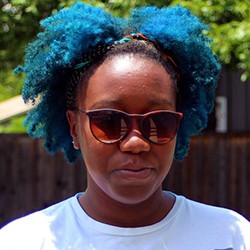Perusing the thousands of YouTube videos about natural hair, I’ve stumbled upon many mixtures and concoctions, all using ingredients found in
the fridge or pantry. “Great,” I thought, “No more trips to the store — no more product junkie!”
I was so eager to try the first thing that promoted soft hair or springy coils. But what I failed to do was research exactly what I was putting into my hair, and how my hair would react. We have to dive a little into chemistry and biology to truly understand why our hair reacts the way it does, no matter if the ingredient is “natural” or good enough to eat.
First up is the baking soda shampoo and conditioner mix. Is it actually good for our hair? Why or not? After receiving lackluster results, I decided to find out.
Many naturals have promoted baking soda because it cleanses the hair as a shampoo and softens the hair as a conditioner. Some have even promoted it as something to loosen the curl pattern.
It's all about the pH
Many naturals have promoted baking soda, or sodium bicarbonate, as an ingredient that cleanses the hair as a shampoo and softens the hair as a conditioner. Some have even promoted it as something to loosen the curl pattern.
Baking soda is in fact, a chemical, so to understand its effects on our hair, we need to understand its pH. If you think back to good ol’ high school chemistry, pH ranges from 0–14, acid to base (alkaline). If something is an acid, it has more hydrogen ions. If something is alkaline, it has more hydroxide ions. A neutral pH is 7.0—the pH of distilled water.
A common example of an acid is lemon juice, with a pH of 2 or 3. Sodium hydroxide, the chemical used in lye relaxers for hair, is extremely alkaline with a pH of 14 (yikes!).
Our hair, when wet, has a pH of about 4.5-5.5. As you can see, human hair is slightly acidic when in its natural state. When applying products to our hair, the key is BALANCE. For our hair to stay natural and healthy, the pH must remain the same. Even the water we use in the shower will raise the pH of our hair! This is why hair products are usually pH balanced. The company takes pH into consideration when creating the product.
What baking soda actually does to your hair
With this newfound respect for balance, here is the most important piece of information. Baking soda, the product I was putting in my hair, has a whopping pH of 9.0! It was raising the pH of my hair! The fact that something is acidic or alkaline is more than just a label. It actually affects our strands in a certain way.
Picture each strand of hair as a tube of layers. The outermost layer is called the cuticle. An acid will close the cuticle layers, while a base will open them. Neither action is bad on its own. But once again, balance is key.
When the cuticle is raised, moisture is allowed into the hair, but it is also let out. If something isn’t done to close the cuticle back up, any moisture that was applied is lost. Things like temperature even affect the hair cuticle. For example, hot water opens the cuticle, while cold water shocks it shut. That is why most naturals shampoo their hair with warm water, but rinse the conditioner out with cold.
So, alkalines open the cuticle, while acids close it. Baking soda mixtures like the rinse and conditioner will cause our hair to absorb too much water (yes there is such a thing as too much moisture!). Without anything to lower the pH of our hair back to normal 4.5- 5.5 and close those layers, the moisture will not be retained. As a result, those layers will stay raised and jagged, making the hair feel rough and unmanageable.
How to find the balance
If you have tried the baking soda mixtures, you probably noticed the grittiness of the concoction. On the molecular level, baking soda is actual quite abrasive. After all, we use it to scrub the grime off our pots and pans, right?
When we use it for heavy cleaning, we are also taking advantage of its absorbency. In fact, our straight-haired friends can use it as a dry shampoo. Applied to the roots, it soaks up the oil that visibly travels down the strands of a straight hair.
This led me to question: if it is used to soak up oily hair, how is it possible that it would benefit my coily, dry 4b hair? I admit, this would be a good strong cleanser after a protective style like kinky-twist extensions. But that’s when I haven’t been able to wash my hair for 2 months!
I thought back to my experience with the baking soda conditioner. It is important to note that the mixture did consist of my favorite store-bought conditioner, so the pH was probably not as alkaline as pure baking soda. Nonetheless, the goal of our hair products should be to leave the pH of our hair balanced, or at least move it in the acidic direction where it belongs, so the cuticle will lie flat, locking precious moisture in.
According to my research and experience, the curlier/kinkier the hair, the more beneficial it would be to just leave this product in your pantry.
DO IT YOURSELF
If you're looking to see how baking soda affects your hair, try one of these DIY recipes and tell us how it goes!
Baking Soda Rinse
- ½ cup baking soda
- 1 cup warm water
Allow to dissolve, and apply to scalp and hair. Massage. Can be used after regular shampooing or in place of it.
Baking Soda Conditioner
- ½ cup baking soda
- 1 cup of your favorite conditioner
Mix thoroughly and smooth onto hair. let sit with shower cap for 15-20 minutes. Rinse.
What's your experience with baking soda?




No comments:
Post a Comment
Thanks for sharing your thoughts.. We cherish it...